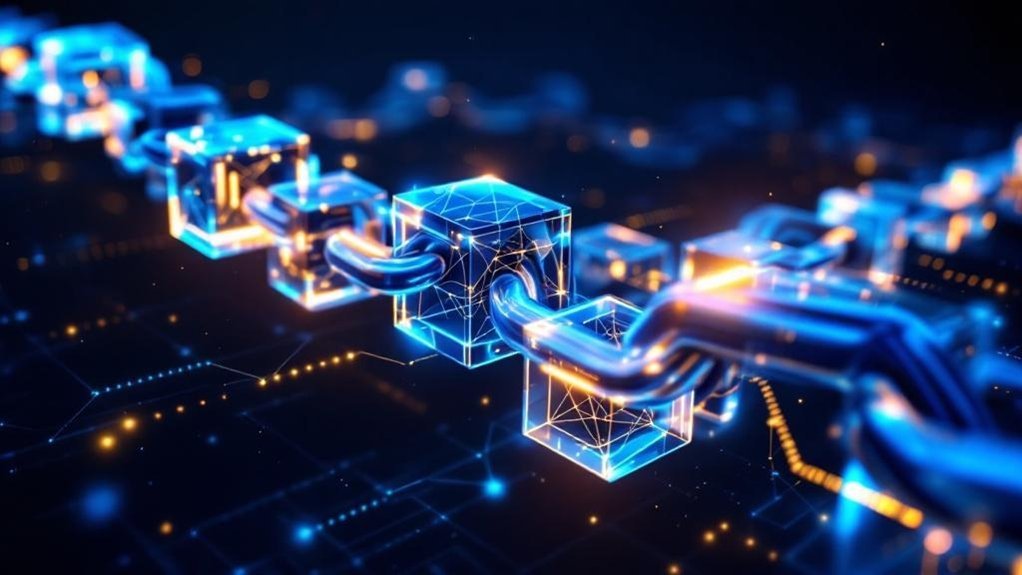Blockchain is a revolutionary digital ledger system that never forgets and can’t be fooled. Think of it as an endless chain of information blocks, each containing transaction data and cryptographic links to previous blocks. The system operates through a decentralized network of computers worldwide, making it virtually hack-proof. While cryptocurrency sparked its fame, blockchain now transforms everything from banking to supply chains. The digital revolution is just warming up.

A digital revolution is quietly reshaping how we track and verify everything from money to medical records. At its core, blockchain is a fancy database – but one that’s fundamentally different from anything we’ve seen before.
Think of it as an endless digital ledger that keeps growing, never forgets, and absolutely hates liars.
The genius of blockchain lies in its structure. Every transaction gets bundled into a “block” that’s linked to the previous one using complex cryptography. These transactions are permanently recorded in a transparent and immutable way.
These blocks form an unbreakable chain, each containing a timestamp and a digital fingerprint of the block before it. Try to mess with any single block, and the whole chain screams foul. It’s like having millions of accountants checking each other’s work, except they’re computers, and they never take coffee breaks.
What makes blockchain truly revolutionary is its decentralized nature. There’s no single computer controlling everything – the data exists simultaneously across countless machines worldwide. The technology was first invented by Satoshi Nakamoto in 2008.
Good luck trying to hack that. When someone wants to add new information, the network’s participants must agree it’s legitimate through consensus mechanisms. Some systems use “proof of work” (aka mining), while others prefer “proof of stake.” Either way, it’s democracy in action, just with more math and fewer campaign promises.
The applications are endless, and cryptocurrency was just the beginning. Financial institutions are using blockchain to make transfers faster and cheaper. Digital wallets store and secure these crypto assets, making them accessible yet protected.
Supply chain managers can track products from factory to shelf with unprecedented accuracy. Even concert tickets can’t be faked anymore – blockchain makes sure of that.
No middlemen, no shenanigans, just pure, unadulterated truth.
The technology isn’t perfect – nothing is. But it’s changing how we think about trust in the digital age.
Blockchain creates transparency where there was opacity, security where there was vulnerability, and certainty where there was doubt.
It’s not magic; it’s mathematics, cryptography, and computer science working together to build something revolutionary. And it’s here to stay.
Frequently Asked Questions
How Much Energy Does Blockchain Mining Consume Globally?
Global blockchain mining devours a massive amount of electricity.
Bitcoin alone gulps down 168 terawatt-hours annually – roughly what Finland uses in a year. That’s about 0.2% to 0.9% of global electricity consumption.
Mining operations run 24/7, drawing about 10 gigawatts of continuous power. Pretty wild considering it’s just computers solving math problems.
The energy could power 8-9 million homes instead.
Can Blockchain Transactions Be Traced by Government Authorities?
Yes, government authorities can trace blockchain transactions quite effectively.
They use sophisticated analytics platforms to follow money trails across multiple blockchains. Every transaction leaves a permanent record on public ledgers.
Law enforcement combines these tools with traditional investigation methods, subpoenas, and exchange data to identify real people behind digital wallets.
Even “anonymous” transactions aren’t so anonymous anymore. Crypto criminals, beware.
What Programming Languages Are Most Commonly Used in Blockchain Development?
Solidity dominates smart contract development, period.
It’s the go-to for Ethereum and similar blockchains. But there’s more.
Go rocks distributed systems, while Java handles enterprise stuff. Python keeps things simple, and C++ powers Bitcoin itself.
Rust is the new kid, turning heads with its security features.
Each serves different needs – from smart contracts to core protocols. No one-size-fits-all here.
How Do Blockchain Gas Fees Work and What Affects Them?
Gas fees are the price users pay to perform transactions on blockchain networks. Simple as that.
They fluctuate based on network traffic – busy times mean higher fees. Think of it like surge pricing for crypto.
The more complex the transaction, the more gas needed. After Ethereum’s 2021 upgrade, fees include a base rate plus optional “tips” to speed things up.
Network congestion and transaction complexity are the big drivers.
Which Industries Beyond Finance Are Actively Implementing Blockchain Technology?
Multiple industries are embracing blockchain beyond finance.
Supply chain companies use it to track products from source to shelf. Energy firms enable peer-to-peer trading of renewable power.
Real estate leverages blockchain for property tokenization and faster transactions. Education institutions verify credentials.
Even media companies tackle piracy through blockchain platforms. Manufacturing, agriculture, and pharmaceuticals use it for authenticity verification and ethical compliance tracking.
